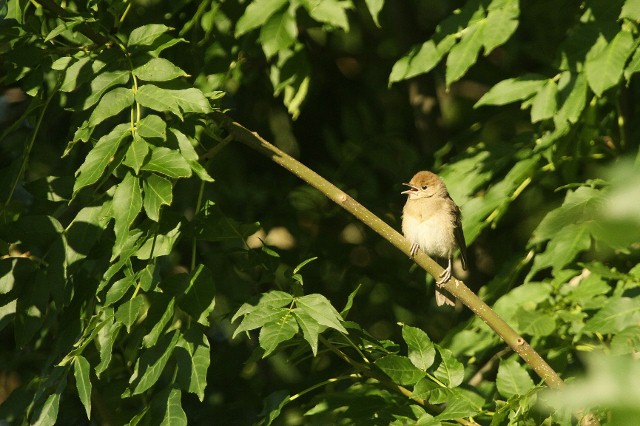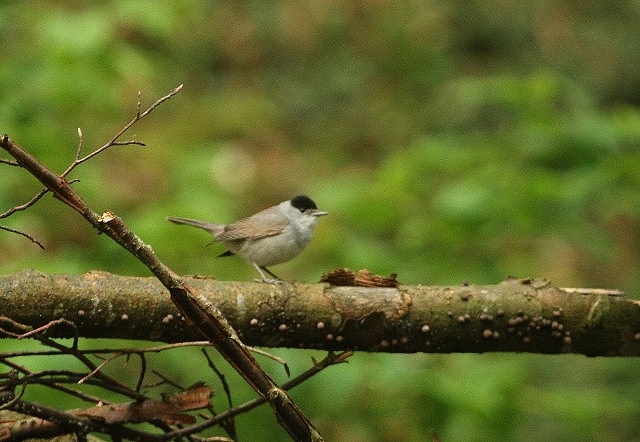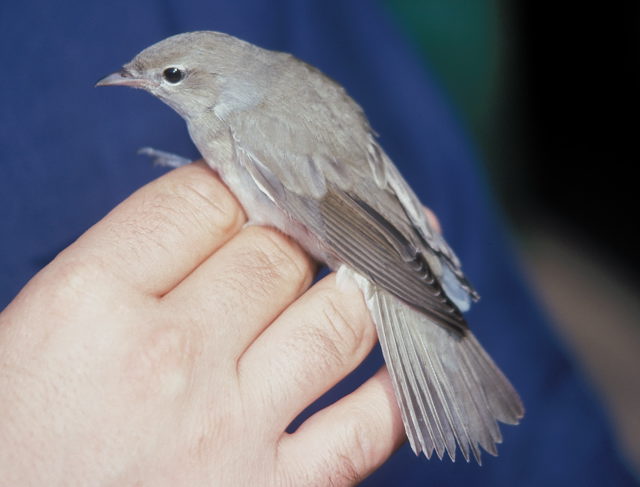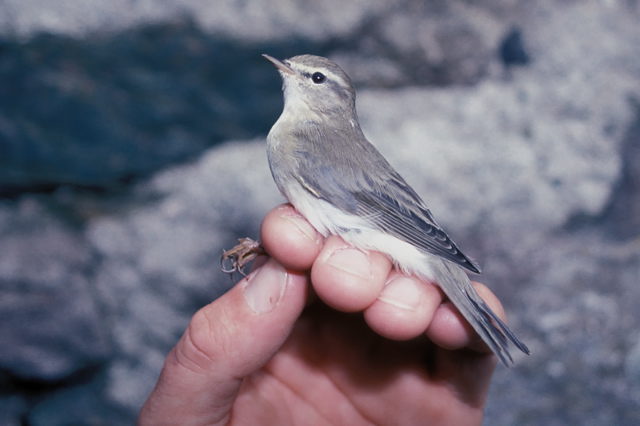Sylviidae is a family of passerine birds that was part of an assemblage known as the Old World warblers. The family was formerly a wastebin taxon with over 400 species of bird in over 70 genera. The family was poorly defined with many characteristics shared with other families. Advances in classification, particularly helped with molecular data, have led to the splitting out of several new families from within this group. Today the smaller family Sylviidae sensu strictu includes the typical warblers in the genus Sylvia, the parrotbills of Asia (formerly a separate family Paradoxornithidae) and a number of babblers formerly placed within the family Timaliidae.
They are small to medium-sized, with generally thin, pointed bill with bristles at the base, a slender shape and an inconspicuos and mostly plain plumage. Then wings show ten primaries feather, and are rounded and short in non-migratory species. They have longish tails.
The typical warblers are small birds belonging to the genus Sylvia. There are 28 species currently included in the genus. Typical warblers occur in the temperate to tropical regions of Europe, western and central Asia, and Africa, with the highest species diversity centred around the Mediterranean.
They are strongly built, with stouter legs and a slightly thicker bill than many other warblers, and range in size from 11 cm length and 7 g weight (African Desert Warbler) up to 17 cm length and 36 g weight (Barred Warbler). The plumage is based around varying shades of grey and brown, usually darker above and paler below, with bluish or pinkish tones in several species; several also have orange-brown or rufous fringed wing feathers. The tail is square-ended in most, slightly rounded in a few, and in several species has white sides. Many of the species show some sexual dimorphism, with distinctive male and female plumages, with the males in many having black or bright grey on the heads, replaced by brown, brownish-grey or similar dusky colours in females; about a third of the species also have a conspicuous red eye ring in males. Species breeding in cool temperate regions are strongly migratory, while most of those in warmer regions are partially migratory or resident. They are active warblers usually associated with open woodland, scrub, hedges or shrubs. Their diet is largely insectivorous, though several species also eat fruit extensively, mainly small berries.
Africa Wild Bird Book
Family Sylviidae (Sylviid Babblers, True Warblers) Index
Family Sylviidae (True Warblers, Sylviid Babblers)
Lioptilus nigricapillus Bush Blackcap 565
Sylvia atricapilla Eurasian Blackcap 911
Sylvia borin Garden Warbler 619
Sylvia communis Common Whitethroat 620
Sylvia subcaerulea Chestnut-vented Warbler, Chestnut-vented Tit-babbler 621 (moved from genus Parisoma to Sylvia)
Sylvia layardi Layard's Warbler, Layard's Tit-babbler 622(moved from genus Parisoma to Sylvia)
Lioptilus nigricapillus Bush Blackcap 565
Sylvia atricapilla Eurasian Blackcap 911
Sylvia borin Garden Warbler 619
Sylvia communis Common Whitethroat 620
Sylvia subcaerulea Chestnut-vented Warbler, Chestnut-vented Tit-babbler 621 (moved from genus Parisoma to Sylvia)
Sylvia layardi Layard's Warbler, Layard's Tit-babbler 622(moved from genus Parisoma to Sylvia)
- nan
- Posts: 26476
- Joined: Thu May 31, 2012 9:41 pm
- Country: Switzerland
- Location: Central Europe
- Contact:
Eurasian Blackcap
911. Eurasian Blackcap Sylvia atricapilla (Swartkroonsanger)
Order: Passeriformes. Family: Sylviidae
Description
Size 13-15 cm. Both sexes have a neat coloured cap to the head, black in the male and reddish-brown in the female.
The adult male has olive-grey upperparts, other than a paler grey nape and a neat black cap on the head. The underparts are light grey, becoming silvery white on the chin, throat and upper breast. The tail is dark grey, with an olive tint to the outer edge of each feather. The bill and long legs are grey, and the iris is reddish-brown.
The female resembles the male, but has a reddish-brown cap and a slightly browner tone to the grey of the upperparts.
Juveniles are similar to the female, but their upperparts have a slight rufous tinge, and the breast and flanks have a more olive tone; young males have a darker brown cap than their female counterparts.
Similar species: Male not likely to be confused with Bush Blackcap because of its much smaller size and its black (not pink) bill and feet
Distribution
Breeds across much of Eurasia, heading south in the non-breeding season to parts of West Africa, Ethiopia south through Tanzania to Malawi. There are have been a number of records of it in southern Africa, in northern Namibia, Zimbabwe's eastern highlands and one from Johannesburg. It prefers dense undergrowth in woodland, which may cause it to be under-recorded in southern Africa, due to its unobtrusiveness.
Habitat
Thick bush and forest edge.
Diet
The diet of the blackcap varies seasonally, comprising mainly insects during the breeding season and fruit during the rest of the year. Blackcaps eat a wide variety of insects and other invertebrates, including mayflies, dragonflies, grasshoppers, moths, beetles, spiders, woodlice, snails and earthworms. Prey may be taken from leaves or twigs, or is sometimes caught in the air. A range of different fruits and berries are also eaten. Smaller fruits are swallowed whole, but the blackcap may peck at the pulp of larger fruits. The blackcap may also take pollen, nectar and some insects outside of the breeding season.
Breeding
The nest is built in a low shrub, and 3–6 eggs are laid.
Call
Similar to Garden Warbler's but more varied and less subdued. Listen to Bird Call.
Status
Very rare summer vagrant.
Order: Passeriformes. Family: Sylviidae
Description
Size 13-15 cm. Both sexes have a neat coloured cap to the head, black in the male and reddish-brown in the female.
The adult male has olive-grey upperparts, other than a paler grey nape and a neat black cap on the head. The underparts are light grey, becoming silvery white on the chin, throat and upper breast. The tail is dark grey, with an olive tint to the outer edge of each feather. The bill and long legs are grey, and the iris is reddish-brown.
The female resembles the male, but has a reddish-brown cap and a slightly browner tone to the grey of the upperparts.
Juveniles are similar to the female, but their upperparts have a slight rufous tinge, and the breast and flanks have a more olive tone; young males have a darker brown cap than their female counterparts.
Similar species: Male not likely to be confused with Bush Blackcap because of its much smaller size and its black (not pink) bill and feet
Distribution
Breeds across much of Eurasia, heading south in the non-breeding season to parts of West Africa, Ethiopia south through Tanzania to Malawi. There are have been a number of records of it in southern Africa, in northern Namibia, Zimbabwe's eastern highlands and one from Johannesburg. It prefers dense undergrowth in woodland, which may cause it to be under-recorded in southern Africa, due to its unobtrusiveness.
Habitat
Thick bush and forest edge.
Diet
The diet of the blackcap varies seasonally, comprising mainly insects during the breeding season and fruit during the rest of the year. Blackcaps eat a wide variety of insects and other invertebrates, including mayflies, dragonflies, grasshoppers, moths, beetles, spiders, woodlice, snails and earthworms. Prey may be taken from leaves or twigs, or is sometimes caught in the air. A range of different fruits and berries are also eaten. Smaller fruits are swallowed whole, but the blackcap may peck at the pulp of larger fruits. The blackcap may also take pollen, nectar and some insects outside of the breeding season.
Breeding
The nest is built in a low shrub, and 3–6 eggs are laid.
Call
Similar to Garden Warbler's but more varied and less subdued. Listen to Bird Call.
Status
Very rare summer vagrant.
Kgalagadi lover… for ever
https://safrounet.piwigo.com/
https://safrounet.piwigo.com/
- nan
- Posts: 26476
- Joined: Thu May 31, 2012 9:41 pm
- Country: Switzerland
- Location: Central Europe
- Contact:
Garden Warbler
619. Garden Warbler Sylvia borin (Tuinsanger)
Order: Passeriformes. Family: Sylviidae
Description
13-14.5 cm. A plump long-winged and long-tailed warbler with round head and stubby bill. Rather featureless plumage with uniform olive brown-grey upperparts and paler dull white underparts. It has a whitish eyering and a faint pale supercilium, and there is a buff wash to the throat and flanks. The eye is black, the legs are steel-grey and the strong bill has a grey upper and pale lower mandible. Note lack of distinctive markings such as eyestripes or wingbars. Sexes alike.
Juveniles are paler and greyer above, have a buff tone to the underparts and looser plumage.
Distribution
Its breeding grounds stretch from Europe to Russia; in the non-breeding season it head south to much of sub-Saharan Africa, only excluding parts of Ethiopia and Somalia.
Habitat
Thick bush. In southern Africa it is locally common in habitats with dense vegetation, such as forest edges, thickets in woodland, moist coastal bush and well-wooded gardens and parks.
Movements and migrations
It arrives in southern Africa from September-November, staying until about March-April.
Diet
It eats a variety of invertebrates and fruit or berries, doing most of its foraging in the undergrowth, gleaning prey from leaves and twigs and occasionally hawking an insect.
Call
Sustained mellow but forceful warbling song; alarm call hard vik or vik-vik. Listen to Bird Call.
Status
Common visitor to the region in summer.
Order: Passeriformes. Family: Sylviidae
Description
13-14.5 cm. A plump long-winged and long-tailed warbler with round head and stubby bill. Rather featureless plumage with uniform olive brown-grey upperparts and paler dull white underparts. It has a whitish eyering and a faint pale supercilium, and there is a buff wash to the throat and flanks. The eye is black, the legs are steel-grey and the strong bill has a grey upper and pale lower mandible. Note lack of distinctive markings such as eyestripes or wingbars. Sexes alike.
Juveniles are paler and greyer above, have a buff tone to the underparts and looser plumage.
Distribution
Its breeding grounds stretch from Europe to Russia; in the non-breeding season it head south to much of sub-Saharan Africa, only excluding parts of Ethiopia and Somalia.
Habitat
Thick bush. In southern Africa it is locally common in habitats with dense vegetation, such as forest edges, thickets in woodland, moist coastal bush and well-wooded gardens and parks.
Movements and migrations
It arrives in southern Africa from September-November, staying until about March-April.
Diet
It eats a variety of invertebrates and fruit or berries, doing most of its foraging in the undergrowth, gleaning prey from leaves and twigs and occasionally hawking an insect.
Call
Sustained mellow but forceful warbling song; alarm call hard vik or vik-vik. Listen to Bird Call.
Status
Common visitor to the region in summer.
Dewi
What is the good of having a nice house without a decent planet to put it on? (H D Thoreau)
What is the good of having a nice house without a decent planet to put it on? (H D Thoreau)
Garden Warbler Photos
Dewi
What is the good of having a nice house without a decent planet to put it on? (H D Thoreau)
What is the good of having a nice house without a decent planet to put it on? (H D Thoreau)
Common Whitethroat
620. Common Whitethroat Sylvia communis (Witkeelsanger)
Order: Passeriformes. Family: Sylviidae
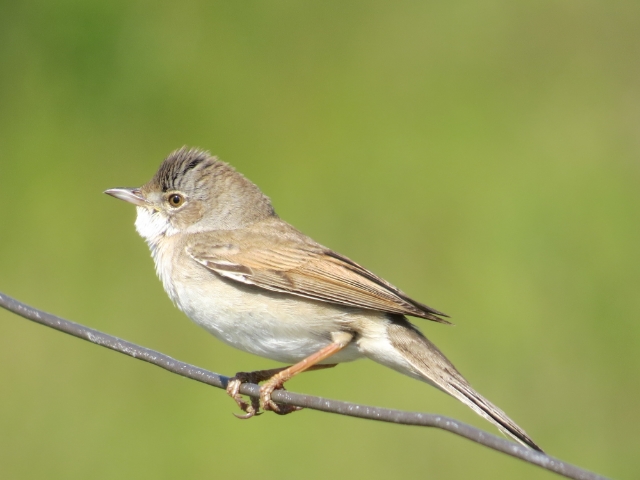
Description
Length 13-15 cm, mass: 16 g.
A sturdy and large-headed warbler with a fairly long white-sided tail. The mantle, back and scapulars are a rather drab brown. The legs and the base of the lower mandible are pale, varying from yellowy through flesh to horn. At rest, the key feature to look for is the rusty fringing to all the wing feathers, producing a conspicuous rusty panel on the closed wing. The underparts vary from pinkish (males) to buffish (females) but, they always contrast strongly with the prominent white throat.
This is one of several Sylvia species that has distinct male and female plumages.
The male has a greyish head, a white orbital ring and a grey-brown back, and in all plumages shows broad bright rufous margins to the secondaries, tertials and wing coverts. The underparts are whitish, with pure white on the throat contrasting with a pink flush on the breast.
The female is browner, washed buff on the breast, with a brown head, pale orbital eyering and pale brown eye.
Distribution
Its breeding grounds are from western Europe to north-west Africa and Mongolia; in the non-breeding season it heads south to sub-Saharan Africa, occurring in a band from Senegal to Ethiopia south to southern Africa. Here its distribution is centered around Botswana, extending into Zimbabwe, northern South Africa and north-eastern Namibia. This Palearctic migrant is a visitor to the dry savannas of sub-Saharan Africa.
Habitat
Dry thornveld thickets, often near water with scattered Acacia trees, or with miombo (Brachystegia) and Zambezi teak (Baikiaea plurijuga), especially with undergrowth containing fruit-bearing shrubs. It prefers dense shrubland and the understorey of woodland in the Kalahari and adjacent biomes north of 28°S. In the Kalahari it is particularly attracted to stands with small berries, such as Grewia spp.
Movements and migrations
It mainly arrives in southern Africa from late November-December, departing from March-April.
Diet
It eats a variety of insects and fruit, often foraging solitarily but also joining mixed-species foraging flocks.
Breeding
The nest is built always near the ground in bushes, thickets of nettle or wormwood. Like all warblers, they construct their nest as a woven "bowl". On the top edge of the nest, there is a border made of white lumps of vegetative fluff. Walls are not dense; they are made mainly of last year’s blades. A lining inside the nest often contains mammals’ hair. 3-7 eggs are laid in May, incubated by both parents for 11–13 days. Fledglings remain in nest for 9–14 days.
Call
Quite vocal, with a range of call notes, such as a nervous, nasal dverhr dverhr dverhr and a low dzhuurrr, a lively whit-whit-whit which often precedes song, and a sharp, often repeated tak. The song is a brisk and lively warble, quite shrill and scratchy and delivered from a raised perch, or a little longer, richer and more fluid when given in a jerky little song flight. In its simplest version it is just 1-1.5 seconds long, with 6-12 note components, such as an easy-to-remember witchetty-witchetty-witchetty-witch! or more accurately as weech'u-cheh'weh-i'chu-chi'chiih!, often slightly descending through the sequence and ascending sometimes on the final two or three notes. Longer and more complex versions can last up to 10 seconds or more, and sound more warbling and similar to other Sylvia species.
Listen to Bird Call.
Status
Not threatened. Locally common summer visitor.
Order: Passeriformes. Family: Sylviidae

Description
Length 13-15 cm, mass: 16 g.
A sturdy and large-headed warbler with a fairly long white-sided tail. The mantle, back and scapulars are a rather drab brown. The legs and the base of the lower mandible are pale, varying from yellowy through flesh to horn. At rest, the key feature to look for is the rusty fringing to all the wing feathers, producing a conspicuous rusty panel on the closed wing. The underparts vary from pinkish (males) to buffish (females) but, they always contrast strongly with the prominent white throat.
This is one of several Sylvia species that has distinct male and female plumages.
The male has a greyish head, a white orbital ring and a grey-brown back, and in all plumages shows broad bright rufous margins to the secondaries, tertials and wing coverts. The underparts are whitish, with pure white on the throat contrasting with a pink flush on the breast.
The female is browner, washed buff on the breast, with a brown head, pale orbital eyering and pale brown eye.
Distribution
Its breeding grounds are from western Europe to north-west Africa and Mongolia; in the non-breeding season it heads south to sub-Saharan Africa, occurring in a band from Senegal to Ethiopia south to southern Africa. Here its distribution is centered around Botswana, extending into Zimbabwe, northern South Africa and north-eastern Namibia. This Palearctic migrant is a visitor to the dry savannas of sub-Saharan Africa.
Habitat
Dry thornveld thickets, often near water with scattered Acacia trees, or with miombo (Brachystegia) and Zambezi teak (Baikiaea plurijuga), especially with undergrowth containing fruit-bearing shrubs. It prefers dense shrubland and the understorey of woodland in the Kalahari and adjacent biomes north of 28°S. In the Kalahari it is particularly attracted to stands with small berries, such as Grewia spp.
Movements and migrations
It mainly arrives in southern Africa from late November-December, departing from March-April.
Diet
It eats a variety of insects and fruit, often foraging solitarily but also joining mixed-species foraging flocks.
Breeding
The nest is built always near the ground in bushes, thickets of nettle or wormwood. Like all warblers, they construct their nest as a woven "bowl". On the top edge of the nest, there is a border made of white lumps of vegetative fluff. Walls are not dense; they are made mainly of last year’s blades. A lining inside the nest often contains mammals’ hair. 3-7 eggs are laid in May, incubated by both parents for 11–13 days. Fledglings remain in nest for 9–14 days.
Call
Quite vocal, with a range of call notes, such as a nervous, nasal dverhr dverhr dverhr and a low dzhuurrr, a lively whit-whit-whit which often precedes song, and a sharp, often repeated tak. The song is a brisk and lively warble, quite shrill and scratchy and delivered from a raised perch, or a little longer, richer and more fluid when given in a jerky little song flight. In its simplest version it is just 1-1.5 seconds long, with 6-12 note components, such as an easy-to-remember witchetty-witchetty-witchetty-witch! or more accurately as weech'u-cheh'weh-i'chu-chi'chiih!, often slightly descending through the sequence and ascending sometimes on the final two or three notes. Longer and more complex versions can last up to 10 seconds or more, and sound more warbling and similar to other Sylvia species.
Listen to Bird Call.
Status
Not threatened. Locally common summer visitor.
10.03. - 24.03.2015 From Berg to bush
19.11. - 01.12.2015 KTP
19.11. - 01.12.2015 KTP
Common Whitethroat Photos
620. Common Whitethroat Sylvia communis

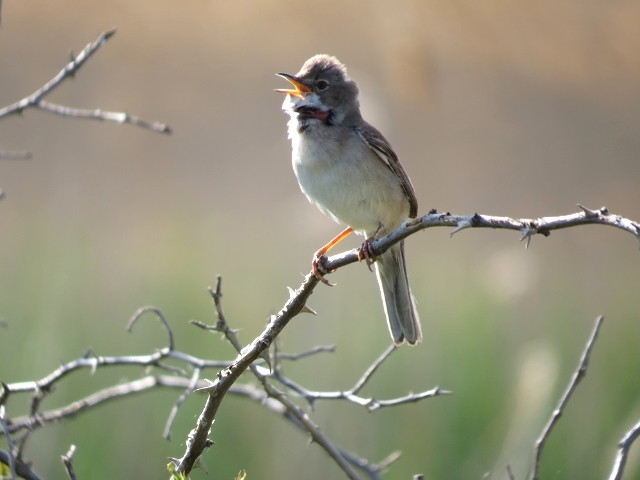
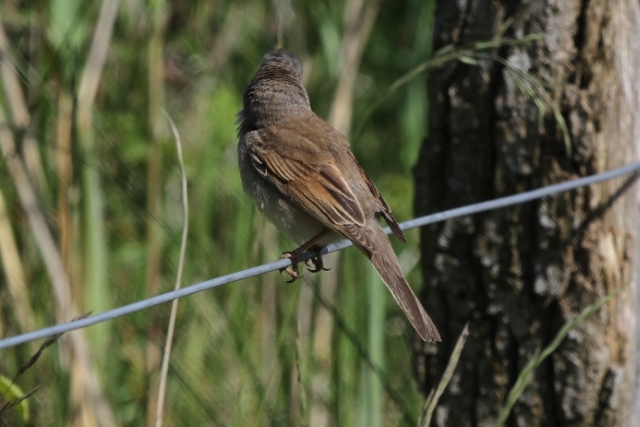
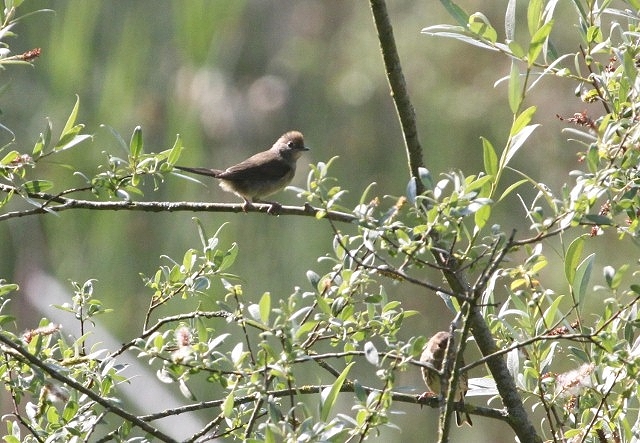 © nan
© nan
Links:
Species text Sabap1: http://sabap2.adu.org.za/docs/sabap1/620.pdf
Sabap2: http://sabap2.adu.org.za/spp_summary.ph ... §ion=3
Wikipedia: http://en.wikipedia.org/wiki/Common_whitethroat
http://www.biodiversityexplorer.org/bir ... mmunis.htm
IDENTIFYING WARBLERS
Birdwatch Articles - Common and Lesser Whitethroats
http://www.birds-home.com/Thrushes-Warb ... throat.htm
http://www.new-ecopsychology.org/en/bir ... p-2-10.htm



 © nan
© nanLinks:
Species text Sabap1: http://sabap2.adu.org.za/docs/sabap1/620.pdf
Sabap2: http://sabap2.adu.org.za/spp_summary.ph ... §ion=3
Wikipedia: http://en.wikipedia.org/wiki/Common_whitethroat
http://www.biodiversityexplorer.org/bir ... mmunis.htm
IDENTIFYING WARBLERS
Birdwatch Articles - Common and Lesser Whitethroats
http://www.birds-home.com/Thrushes-Warb ... throat.htm
http://www.new-ecopsychology.org/en/bir ... p-2-10.htm
10.03. - 24.03.2015 From Berg to bush
19.11. - 01.12.2015 KTP
19.11. - 01.12.2015 KTP
- Flutterby
- Posts: 44029
- Joined: Sat May 19, 2012 12:28 pm
- Country: South Africa
- Location: Gauteng, South Africa
- Contact:
Chestnut-vented Warbler
621. Chestnut-vented Warbler Sylvia subcaerulea (formerly: Chestnut-vented Tit-babbler) (Bosveld-tjerik-tik)
Order: Passeriformes. Family: Sylviidae
Description
The Chestnut-vented Warbler is 14–15 cm long and weighs around 16 g. Chestnut undertail coverts diagnostic at all ages. Sexes alike.
Adult: Forehead brownish grey, crown and remainder of upper parts, incl scapulars and upper wing coverts, dull blue-grey or brownish grey. Cheeks, ear coverts and sides of neck brownish grey. Tail black, tipped and edged white, white tips broadening laterally. Flight feathers dark brown, edged grey; primary coverts blackish, fringed grey and very narrowly tipped whitish. Chin and throat white, boldly streaked black. Breast and belly grey, rear vent and undertail coverts bright chestnut (diagnostic). Bill black. Eyes white, greyish white or cream. Legs and feet slaty black.
Juvenile undertail coverts are a paler chestnut and throat streaking is indistinct.
Similar species: Layard’s Warbler is the only similar species, but is paler, has more white in the tail, and lacks the chestnut vent.
Distribution
From Angola south to southern Africa, where it is common across much of the region, excluding Mozambique and parts of Zimbabwe and eastern South Africa.
Habitat
Semi-arid woodland and shrublands.
Diet
It mainly eats insects gleaned from branches, supplemented with fruit. It is an agile foraging, rapidly moving through foliage in search prey and occasionally hawking termite alates.
Breeding
This species is monogamous, pairing for life. Season: August to December in sw Cape, August to March (mainly October-December) in North-west and Limpopo, October to January in KwaZulu-Natal, September to March (mainly September-November) in Zimbabwe, December to April in sw Kalahari (where probably partly opportunistic after rain).The nest is a thin-walled cup built of dry grass, rootlets and strips of silk bark, secured with spider web. It is typically placed in the branches of a bush or small tree, occasionally in mistletoe. The eggs are white, spotted with brown. It lays 2-4 eggs, which are incubated by both sexes for about 13-16 days. The chicks are cared for by both parents, leaving the nest after about 14-15 days.
Call
The call is a loud fluted cheerup-chee-chee.
Status
Near-endemic; common resident.
Order: Passeriformes. Family: Sylviidae
Description
The Chestnut-vented Warbler is 14–15 cm long and weighs around 16 g. Chestnut undertail coverts diagnostic at all ages. Sexes alike.
Adult: Forehead brownish grey, crown and remainder of upper parts, incl scapulars and upper wing coverts, dull blue-grey or brownish grey. Cheeks, ear coverts and sides of neck brownish grey. Tail black, tipped and edged white, white tips broadening laterally. Flight feathers dark brown, edged grey; primary coverts blackish, fringed grey and very narrowly tipped whitish. Chin and throat white, boldly streaked black. Breast and belly grey, rear vent and undertail coverts bright chestnut (diagnostic). Bill black. Eyes white, greyish white or cream. Legs and feet slaty black.
Juvenile undertail coverts are a paler chestnut and throat streaking is indistinct.
Similar species: Layard’s Warbler is the only similar species, but is paler, has more white in the tail, and lacks the chestnut vent.
Distribution
From Angola south to southern Africa, where it is common across much of the region, excluding Mozambique and parts of Zimbabwe and eastern South Africa.
Habitat
Semi-arid woodland and shrublands.
Diet
It mainly eats insects gleaned from branches, supplemented with fruit. It is an agile foraging, rapidly moving through foliage in search prey and occasionally hawking termite alates.
Breeding
This species is monogamous, pairing for life. Season: August to December in sw Cape, August to March (mainly October-December) in North-west and Limpopo, October to January in KwaZulu-Natal, September to March (mainly September-November) in Zimbabwe, December to April in sw Kalahari (where probably partly opportunistic after rain).The nest is a thin-walled cup built of dry grass, rootlets and strips of silk bark, secured with spider web. It is typically placed in the branches of a bush or small tree, occasionally in mistletoe. The eggs are white, spotted with brown. It lays 2-4 eggs, which are incubated by both sexes for about 13-16 days. The chicks are cared for by both parents, leaving the nest after about 14-15 days.
Call
The call is a loud fluted cheerup-chee-chee.
Status
Near-endemic; common resident.
- Flutterby
- Posts: 44029
- Joined: Sat May 19, 2012 12:28 pm
- Country: South Africa
- Location: Gauteng, South Africa
- Contact:
Chestnut-vented Warbler Photos
621. Chestnut-vented Warbler Sylvia subcaerulea
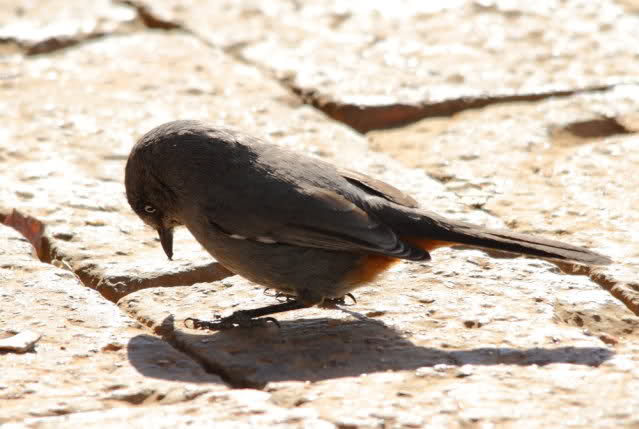 © Flutterby
© Flutterby
 © Mel
© Mel
Kgalagadi Transfrontier Park
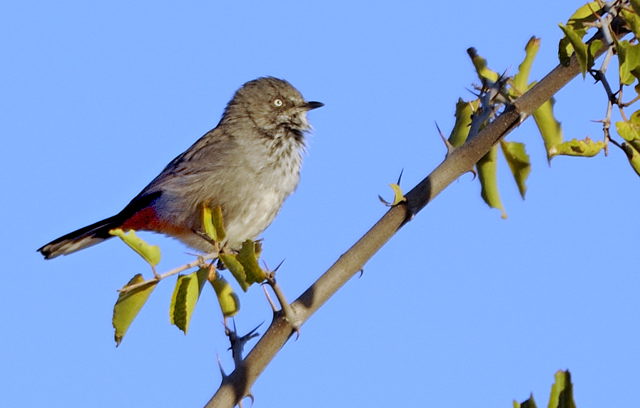 © Dewi
© Dewi
Pilanesberg
Links:
Species text Sabap1
Sabap2
 © Flutterby
© Flutterby © Mel
© MelKgalagadi Transfrontier Park
 © Dewi
© DewiPilanesberg
Links:
Species text Sabap1
Sabap2



